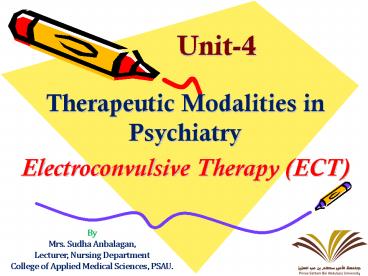Electroconvulsive therapy - PowerPoint PPT Presentation
Title:
Electroconvulsive therapy
Description:
Treatment modalities in psychiatry-Electroconvulsive Therapy (ECT), Focuses on the basics of ECT for nursing students: By- Mrs. Sudha Anbalagan, Lecturer, Nursing Department, CAMS, Prince Sattam bin Abdulaziz University – PowerPoint PPT presentation
Number of Views:1946
Title: Electroconvulsive therapy
1
Unit-4
- Therapeutic Modalities in Psychiatry
- Electroconvulsive Therapy (ECT)
By Mrs. Sudha Anbalagan, Lecturer, Nursing
Department College of Applied Medical Sciences,
PSAU.
2
Introduction
- In a psychiatric setting the treatment may not be
so specific and most patients are given more than
one treatment. - The various treatment modalities in psychiatry
are broadly divided as - Somatic (physical) therapies
- Psychological therapies
- Other therapies included in this unit are
- Milieu therapy
- Therapeutic community
- Activity therapy
3
Introduction
- SOMATICTHERAPIES
- Psychopharmacology
- Antipsychotics
- Antidepressants
- Lithium and Other Mood Stabilizing Drugs
- Anxiolytics and Hypno-sedatives
- Anti-parkinsonian Agents
- Antabuse Drugs
- Drugs Used In Child Psychiatry
- Electroconvulsive Therapy
- Psychosurgery
4
Electroconvulsive Therapy
5
Earliest evidences
- Swiss physician Paracelsus in 1500s, induced
seizures with oral camphor to treat psychiatric
illness.
6
Earliest evidences
- Manfred Sakel, a Viennese physician in 1920s.
- Administered in patients to induce a
hypoglycemic state. (Insulin Shock Therapy)
7
Electrically Induced Seizures
- In 1937, Italian physicians Cerletti Bini
applied electricity to head to induce therapeutic
seizures. - First patient had catatonia and he improved.
- Safer than chemically induced seizures.
- Widespread acceptance through out Europe and USA.
8
Definition
Electroconvulsive therapy is the artificial
induction of a grandmal seizure through the
application of electrical current to the brain.
The stimulus is applied through electrodes.
9
Parameters of Electrical Current Applied
- Standard dose according to American Psychiatric
Association, 1978 - Voltage - 70-120 volts.
- Duration - 0.7-1.5 seconds
10
Type of Seizure Produced
- Grandmal seizure-tonic phase lasting for 10-15
seconds. - Clonic phase lasting for 30-60 seconds.
11
Mechanism of Action
- Neurotransmitter levels all ? in CSF after
seizure, Cerebral blood flow ?. - After seizure, blood flow and metabolism is ?
especially in the frontal lobes.
12
Frequency and Total Number of ECT
- Frequency Three times per week or as indicated.
- Total number 6to 10 upto 25 may be preferred as
indicated.
13
Application of Electrodes
Bilateral ECT Each electrode is placed 2.5-4 cm
(1-1½ inch) above the midpoint, on a line joining
the tragus of the ear and the lateral canthus of
the eye. Unilateral ECT Electrodes are placed
only on one side of head, usually non-dominant
side. Unilateral ECT is safer, with much fewer
side effects particularly those of memory
impairment.
14
Indications Contraindications
- Indications
- Contra Indications
- Raised ICP (intracranial pressure)
- Cerebral aneurysm
- Cerebral hemorrhage
- Brain tumor
- Acute myocardial infarction
- Congestive heart failure
- Pneumonia or aortic aneurysm
- Retinal detachment
- Major depression
- Severe catatonia
- Severe psychosis (schizophrenia or mania)
- Organic mental disorders
- organic mood disorders.
- organic psychosis
15
Side Effects of ECT
- Memory impairment.
- Drowsiness, confusion and restlessness.
- Poor concentration, anxiety.
- Headache, weakness/fatigue, backache, muscle
aches. - Dryness of mouth, palpitations, nausea, vomiting.
- Unsteady gait.
- Tongue bite and incontinence.
16
ECT Team
- Psychiatrist, anesthesiologist, trained nurses
and nursing aides, ECT assistants should be
involved in the administration of ECT.
17
Treatment Facilities
- There should be three rooms
- A pleasant, comfortable waiting room (pre-ECT
room). - ECT room, which should be equipped with
- ECT machine and accessories, an anesthetic
appliance, suction apparatus, face masks, oxygen
cylinders with adjustable flow valves, curved
tongue depressors, mouth gags, - resuscitation apparatus and emergency drugs.
There should be immediate access to a
defibrillator. - A well-equipped recovery room.
18
Role of the Nurse
Before ECT
- Detailed medical and psychiatric history.
- Assessment of patient's and family's knowledge of
indications, side-effects, therapeutic effects
and risks associated with ECT. - An informed consent should be taken.
- Allay fears and anxieties regarding the
procedure. - Assess baseline vital signs.
- Patient should be on empty stomach for 4-6 hours
prior to ECT. - Withhold night doses of drugs.
- Withhold oral medications in the morning.
- Head shampooing in the morning.
- Any jewellery, prosthesis, dentures, contact
lens, metallic objects and tight clothing should
be removed from the patient's body. - Empty bladder and bowel just before ECT.
- Administration of 0.6 mg atropine IM or SC 30
minutes before ECT, or IV just before ECT.
19
Role of the Nurse
During ECT
- Place the patient comfortably on the ECT table in
supine position. - Stay with the patient to allay anxiety and fear.
- Administer the anesthetic agent (thiopental
sodium) and muscle relaxant (succynylcholine). - Patent airway should be ensured and ventilator
support should be started. - Mouth gag should be inserted to prevent possible
tongue bite. - The place(s) of electrode placement should be
cleaned with NS conducting gel applied. - Monitor voltage, intensity and duration of
electrical stimulus given. - Monitor seizure activity using cuff method.
- 100 percent oxygen should be provided.
- During seizure monitor V/S, ECG, oxygen
saturation, EEG, etc. - Record the findings and medicines given in the
patient's chart
20
Role of the Nurse
After ECT
- Monitor vital signs.
- Continue oxygenation till spontaneous respiration
starts. - Assess for post-ictal confusion and restlessness.
- Take safety precautions to prevent injury.
- If there is severe post-ictal confusion and
restlessness, IV diazepam may be administered. - Reorient the patient after recovery and stay with
him until fully oriented. - Document any findings as relevant in the
patient's record.
21
(No Transcript)































